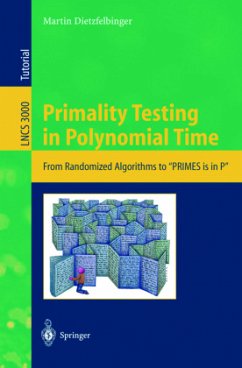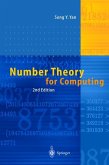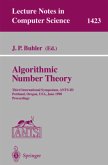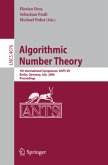A self-contained treatment of theoretically and practically important efficient algorithms for the primality problem. The text covers the randomized algorithms by Solovay-Strassen and Miller-Rabin from the late 1970s as well as the recent deterministic algorithm of Agrawal, Kayal and Saxena. The volume is written for students of computer science, in particular those with a special interest in cryptology, and students of mathematics, and it may be used as a supplement for courses or for self-study.
On August 6, 2002,a paper with the title "PRIMES is in P", by M. Agrawal, N. Kayal, and N. Saxena, appeared on the website of the Indian Institute of Technology at Kanpur, India. In this paper it was shown that the "primality problem"hasa"deterministic algorithm" that runs in "polynomial time". Finding out whether a given number n is a prime or not is a problem that was formulated in ancient times, and has caught the interest of mathema- ciansagainandagainfor centuries. Onlyinthe 20thcentury,with theadvent of cryptographic systems that actually used large prime numbers, did it turn out to be of practical importance to be able to distinguish prime numbers and composite numbers of signi?cant size. Readily, algorithms were provided that solved the problem very e?ciently and satisfactorily for all practical purposes, and provably enjoyed a time bound polynomial in the number of digits needed to write down the input number n. The only drawback of these algorithms is that they use "randomization" - that means the computer that carries out the algorithm performs random experiments, and there is a slight chance that the outcome might be wrong, or that the running time might not be polynomial. To ?nd an algorithmthat gets by without rand- ness, solves the problem error-free, and has polynomial running time had been an eminent open problem in complexity theory for decades when the paper by Agrawal, Kayal, and Saxena hit the web.
Hinweis: Dieser Artikel kann nur an eine deutsche Lieferadresse ausgeliefert werden.
On August 6, 2002,a paper with the title "PRIMES is in P", by M. Agrawal, N. Kayal, and N. Saxena, appeared on the website of the Indian Institute of Technology at Kanpur, India. In this paper it was shown that the "primality problem"hasa"deterministic algorithm" that runs in "polynomial time". Finding out whether a given number n is a prime or not is a problem that was formulated in ancient times, and has caught the interest of mathema- ciansagainandagainfor centuries. Onlyinthe 20thcentury,with theadvent of cryptographic systems that actually used large prime numbers, did it turn out to be of practical importance to be able to distinguish prime numbers and composite numbers of signi?cant size. Readily, algorithms were provided that solved the problem very e?ciently and satisfactorily for all practical purposes, and provably enjoyed a time bound polynomial in the number of digits needed to write down the input number n. The only drawback of these algorithms is that they use "randomization" - that means the computer that carries out the algorithm performs random experiments, and there is a slight chance that the outcome might be wrong, or that the running time might not be polynomial. To ?nd an algorithmthat gets by without rand- ness, solves the problem error-free, and has polynomial running time had been an eminent open problem in complexity theory for decades when the paper by Agrawal, Kayal, and Saxena hit the web.
Hinweis: Dieser Artikel kann nur an eine deutsche Lieferadresse ausgeliefert werden.
From the reviews:
"This book gives an account of the recent proof by M. Agrawal, N. Kayal and N. Saxena ... that one can decide in polynomial time whether a given natural number is prime or composite. ... It presents the background needed from number theory and algebra to make the proof accessible to undergraduates. ... This concise book is written for students of computer science and of mathematics." (Samuel S. Wagstaff, Mathematical Reviews, Issue 2005 m)
"The book can logically be separated into two parts: the first covering introductory material and the second covering the AKS result itself. ... Chapters ... are a joy to read, and I found the proofs and explanations clear and concise. Amazingly, the material is presented in full, with complete proofs given for all results necessary for proving the main results of the book. ... I would enthusiastically and wholeheartedly recommend this book ... ." (Jonathan Katz, SIGACT News, Vol. 37 (1), 2006)
"This book gives an account of the recent proof by M. Agrawal, N. Kayal and N. Saxena ... that one can decide in polynomial time whether a given natural number is prime or composite. ... It presents the background needed from number theory and algebra to make the proof accessible to undergraduates. ... This concise book is written for students of computer science and of mathematics." (Samuel S. Wagstaff, Mathematical Reviews, Issue 2005 m)
"The book can logically be separated into two parts: the first covering introductory material and the second covering the AKS result itself. ... Chapters ... are a joy to read, and I found the proofs and explanations clear and concise. Amazingly, the material is presented in full, with complete proofs given for all results necessary for proving the main results of the book. ... I would enthusiastically and wholeheartedly recommend this book ... ." (Jonathan Katz, SIGACT News, Vol. 37 (1), 2006)








